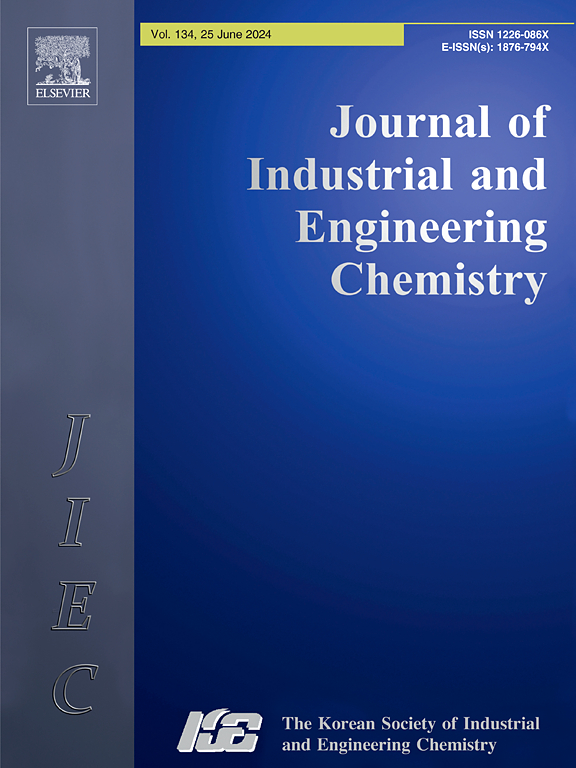In-situ growth of uniform palladium nanoparticles in polythiosemicarbazide membranes for enhanced catalytic reduction and dye degradation
IF 5.9
3区 工程技术
Q1 CHEMISTRY, MULTIDISCIPLINARY
Journal of Industrial and Engineering Chemistry
Pub Date : 2024-12-12
DOI:10.1016/j.jiec.2024.12.004
引用次数: 0
Abstract
This work introduces a novel strategy for embedding palladium nanoparticles (PdNPs) within a polythiosemicarbazide (PTSC) polymeric membrane, achieving non-agglomerated, uniformly dispersed nanoparticles. The PTSC’s unique architecture, featuring a single chelation site per monomer, ensures an abundance of absorption sites, enabling the reduction of metal ions into well-dispersed PdNPs with an average size of 2.3 nm. This approach maximizes the nanoparticle loading capacity while maintaining consistent distribution throughout the membrane matrix. The resulting PdNP-embedded membrane exhibits exceptional catalytic activity, effectively facilitating the reduction of 4-nitrophenol to 4-aminophenol and the degradation of methyl orange dye. Dynamic catalytic processes significantly outperform batch methods, achieving an 80 % conversion of 4-NP to 4-AP seven times faster, and a 70 % degradation of MO in just 20 min, demonstrating an 18-fold efficiency improvement. With only a 1 % PdNPs loading, this system effectively overcomes diffusion limitations, underscoring its potential for scalable applications in environmental catalysis and advanced water treatment technologies. This study not only demonstrates the efficacy of PTSC membranes in catalytic applications but also highlights the broader potential for incorporating uniformly dispersed nanoparticles in polymer matrices for enhanced performance in various chemical engineering processes.

在聚硫代氨基脲膜中原位生长均匀的钯纳米粒子以增强催化还原和染料降解能力
这项工作介绍了一种将钯纳米颗粒(PdNPs)嵌入聚硫脲(PTSC)聚合物膜的新策略,实现了非团聚,均匀分散的纳米颗粒。PTSC的独特结构,每个单体具有单个螯合位点,确保了丰富的吸收位点,使金属离子还原成均匀分散的PdNPs,平均尺寸为2.3 nm。这种方法最大限度地提高了纳米颗粒的负载能力,同时保持了整个膜基质的均匀分布。所得到的pdnp包埋膜表现出优异的催化活性,有效地促进了4-硝基苯酚还原为4-氨基苯酚和甲基橙染料的降解。动态催化过程明显优于批处理方法,将4-NP转化为4-AP的速度提高了7倍,在20分钟内将MO降解70%,效率提高了18倍。该系统只有1%的PdNPs负载,有效地克服了扩散限制,强调了其在环境催化和先进水处理技术中可扩展应用的潜力。这项研究不仅证明了PTSC膜在催化应用中的有效性,而且强调了在聚合物基质中加入均匀分散的纳米颗粒以提高各种化学工程过程性能的广阔潜力。
本文章由计算机程序翻译,如有差异,请以英文原文为准。
求助全文
约1分钟内获得全文
求助全文
来源期刊
CiteScore
10.40
自引率
6.60%
发文量
639
审稿时长
29 days
期刊介绍:
Journal of Industrial and Engineering Chemistry is published monthly in English by the Korean Society of Industrial and Engineering Chemistry. JIEC brings together multidisciplinary interests in one journal and is to disseminate information on all aspects of research and development in industrial and engineering chemistry. Contributions in the form of research articles, short communications, notes and reviews are considered for publication. The editors welcome original contributions that have not been and are not to be published elsewhere. Instruction to authors and a manuscript submissions form are printed at the end of each issue. Bulk reprints of individual articles can be ordered. This publication is partially supported by Korea Research Foundation and the Korean Federation of Science and Technology Societies.

 求助内容:
求助内容: 应助结果提醒方式:
应助结果提醒方式:


